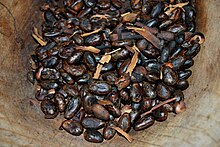La Chonita Hacienda

La Chonita is a former
History
The hacienda’s establishment has been dated to the year 1800, but little has been written about it. Oral tradition states that it was originally called La Chona in reference to the hundreds of acres of lands that originally belonged to it.[1] In the 19th century, the hacienda was the property of the Cruces family, with the first known owner being Benito Cruces, the father of Santiago Cruces Zentella, the governor of Tabasco in the 1870s.[1][2][3] The hacienda lost most of its lands during the Mexican Revolution and is now called La Chonita (“little Chona”). Much of the former property is now La Chonita Ejido. The main hacienda house, along with 30 hectares (0.30 km2) of property now belongs to a family named Fernández.[1]
Description


The hacienda extends over thirty hectares located in the municipality of
It offers various services such as environmental education, workshops on how to prepare chocolate from cacao,
References
- ^ a b c d e f g h i "Hacienda La Chonita" (in Spanish). Cunduacán, Tabasco: Municipality of Cunduacán. January 24, 2010. Archived from the original on May 24, 2011. Retrieved January 4, 2012.
- ^ a b c "Somos" [We are] (in Spanish). Cunduacán, Tabasco: La Chonita. Archived from the original on February 4, 2011. Retrieved January 4, 2012.
- ^ Francisco Triano Coronel (July 16, 2010). "Historia y ecoturismo en la Atenas de la Chontalpa" [History and ecotourism in the Athens of Chontalpa]. Tabasco Hoy (in Spanish). Tabasco, Mexico. Retrieved January 4, 2012.
- ^ "La Ruta del Cacao" (in Spanish). Tabasco, Mexico: Secretaría del Turismode Tabasco. Archived from the original on January 2, 2012. Retrieved January 4, 2012.
- ^ "Las Haciendas en Tabasco". Explorando México (in Spanish). Mexico: Secretaría del Turismo. Retrieved January 4, 2012.
- ^ Román Hernández; Jesús Gómez (February 15, 2010). "Temazcalli te transporta con los dioses" [Temazcals transport you with the gods]. Tabasco Hoy (in Spanish). Tabasco, Mexico. Retrieved January 4, 2012.
